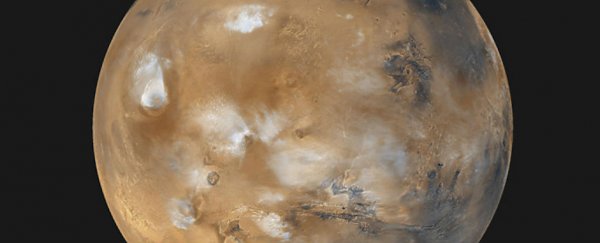Back in March 2012, a mysterious plume of cloud was spotted by amateur astronomers stretching 250 kilometres (about 155 miles) above Mars - far too high up for normal cloud formation. Now, scientists are suggesting the event, which has been debated over since its discovery, was actually caused by the Sun.
Yup, based on data taken from the European Space Agency's (ESA) Mars Express spacecraft, which is currently in orbit around the Red Planet, researchers in Sweden say it looks like a burst of high-energy plasma shot straight from the Sun caused the eerie sight.
These high-energy bursts are known as coronal mass ejections (CMEs), and researchers say one of them struck Mars around the same time the cloud plume appeared, New Scientist's Jacob Aron reports.
Unfortunately, the Mars Express probe doesn't have data on the plume itself, as it was passing over its location during dusk when the cloud wasn't visible.
This isn't the first time a solution has been proposed for the mysterious cloud. In a 2015 paper published in Nature, scientists suggested that the plume was produced by frozen carbon dioxide and water particles condensing in the upper reaches of the atmosphere.
The problem with that hypothesis is that such clouds don't tend to form that high, either on Mars or on Earth.
One of the authors on that 2015 paper, Agustin Sánchez-Lavega from the University of the Basque Country in Spain, thinks this new hypothesis is more credible. "There is a coincidence of both events at Mars, the CME arrival and plume observation," he told Aron. "Therefore, it seems plausible there was a relation between both events."
Despite this support, David Andrews from the Swedish Institute of Space Physics, who led the most recent study, isn't entirely sure. "We're not completely convinced ourselves," he said. "At best all we can say is there is an interesting correlation between two rather extreme events."
Astronomers are still struggling to understand how the plumes are created, even if solar bursts from the Sun are responsible. One idea is that the plasma interacts with ice grains or dust lower down in the atmosphere, and the electrical charge forces them higher up into the sky and even out into space.
Another CME hit Mars last year and was spotted by NASA's MAVEN probe, though no plume was seen on that occasion. For now, scientists are going to keep digging, but the fresh hypothesis might help explain how Mars originally lost its atmosphere.
Mars has changed over billions of years to become the dry and dusty planet we know today, and experts think that CMEs could have helped thin out the atmosphere.
Nicholas Heavens from the Hampton University in Virginia, who wasn't involved in the latest analysis, said it would "change the math", if a link between these plasma bursts and atmosphere change could be proven.
Andrews and his team have presented their findings to the European Geosciences Union in Vienna, Austria, and are expected to submit them for publication shortly.
